2001 MERCEDES-BENZ CLK320 transmission
[x] Cancel search: transmissionPage 6 of 325

3 Contents
DrivingControl and operation of
radio transmitters ..................... 174
The first 1 000 miles
(1 500 km) ................................. 175
Maintenance ................................... 175
Catalytic converter ........................ 176
Emission control ............................ 177
Tele Aid ........................................... 178
Steering lock ................................... 188
Starting and turning off
the engine .................................. 190
Automatic transmission ............... 191
Parking brake .................................200
Driving instructions ......................201
Drive sensibly – save fuel .........201
Drinking and driving ................. 201
Pedals ........................................... 201
Power assistance ........................202Brakes .......................................... 202
Driving off ................................... 203
Parking ........................................ 203
Tires ............................................. 204
Snow chains ............................... 206
Winter driving instructions ..... 207
Winter driving ............................ 208
Deep water .................................. 208
Passenger compartment ........... 209
Traveling abroad ........................ 209
Cruise control .................................210
Brake assist system
(BAS) ...........................................213
Antilock brake system
(ABS) ...........................................215
Electronic stability program
(ESP) ............................................217
What you should know
at the gas station ...................... 221
Check regularly and
before a long trip ...................... 223
Instrument cluster displayMalfunction and
indicator lamps in the
instrument cluster ....................226
On-board diagnostic system
Check engine malfunction
indicator lamp .............................226
Brake warning lamp ..................227
Supplemental restraint system
(SRS) indicator lamp ..................228
Fuel reserve and fuel cap
placement warning ....................228
Electronic stability program
(ESP) — warning lamp ...............229
BAS/ESP malfunction
indicator lamp .............................229
ABS malfunction
indicator lamp .............................229
Telescoping steering column –
indicator lamp .............................230
Seat belt warning lamp .............230
Page 7 of 325

4 Contents
Malfunction and indicator lamps in
the center console .....................230
AIRBAG OFF
indicator lamp .............................230
Malfunction and warning
messages in the
multifunction display ............... 231
DISPLAY DEFECTIVE
(engine control unit) ..................232
DISPLAY DEFECTIVE
(several systems) ........................232
BATTERY/ALTERNATOR ...........233
ABS-SYSTEM ...............................234
BRAKE ASSIST ...........................234
BRAKE LINING WEAR ..............235
BRAKE FLUID .............................235PARKING BRAKE ....................... 236
ENGINE FAN ............................... 236
COOLANT
(coolant level) ............................. 237
COOLANT TEMP.
(coolant temperature) ............... 238
LIGHTING SYSTEM ................... 239
LIGHT SENSOR .......................... 240
STEER. WHEEL ADJUST. .......... 240
ENGINE OIL LEVEL ................... 241
ELEC. STABIL. PROG.
(Electronic stability
program) ..................................... 242
REMOVE KEY ............................. 242
WASHER FLUID ......................... 243
TELE AID ..................................... 244
Practical hintsFirst aid kit .....................................246
Shelf below rear window ..............246
Stowing things in the vehicle ......246
Fuses ................................................247
Hood .................................................249
Checking engine
oil level ....................................... 251
Automatic transmission
fluid level ...................................252
Coolant level ...................................252
Adding coolant ...........................253
Windshield washer/headlamp
cleaning system ........................254
Windshield and
headlamp washer
fluid mixing ratio .......................254
Page 8 of 325

5 ContentsSpare wheel, vehicle tools,
storage compartment ................255
Vehicle jack .....................................256
Wheels .............................................257
Tire replacement ........................257
Rotating wheels ..........................258
Spare wheel ....................................259
Changing wheels ...........................260
Tire inflation pressure ..................265
Battery .............................................266
Jump starting ..................................268
Towing the vehicle .........................270
Transmission selector lever,
manually unlocking ...................272
Exterior lamps ................................273
Headlamp assembly ................... 274
Taillamp assemblies .................. 276Changing batteries in the
electronic main key .................. 281
Synchronizing
remote control ............................ 283
Emergency operation of
sliding/pop-up roof .................. 284
Manual release for
fuel filler flap ............................ 285
Replacing wiper
blade insert ............................... 285
Trunk lamp ..................................... 287
Roof rack ......................................... 287
Vehicle careCleaning and care
of the vehicle ............................. 290
Power washer ............................. 291
Paintwork, painted body
components ................................ 291Tar stains ..................................... 291
Engine cleaning ..........................292
Vehicle washing .........................292
Ornamental moldings ................292
Headlamps, taillamps,
turn signal lenses ......................292
Window cleaning .......................293
Wiper blade .................................293
Light alloy wheels ......................293
Instrument cluster .....................293
Steering wheel and
gear selector lever ......................293
Cup holder ...................................294
Seat belts .....................................294
Hard plastic trim items .............294
Headliner and shelf
below rear window .....................294
Upholstery ...................................294
Plastic and rubber parts ............294
Page 176 of 325
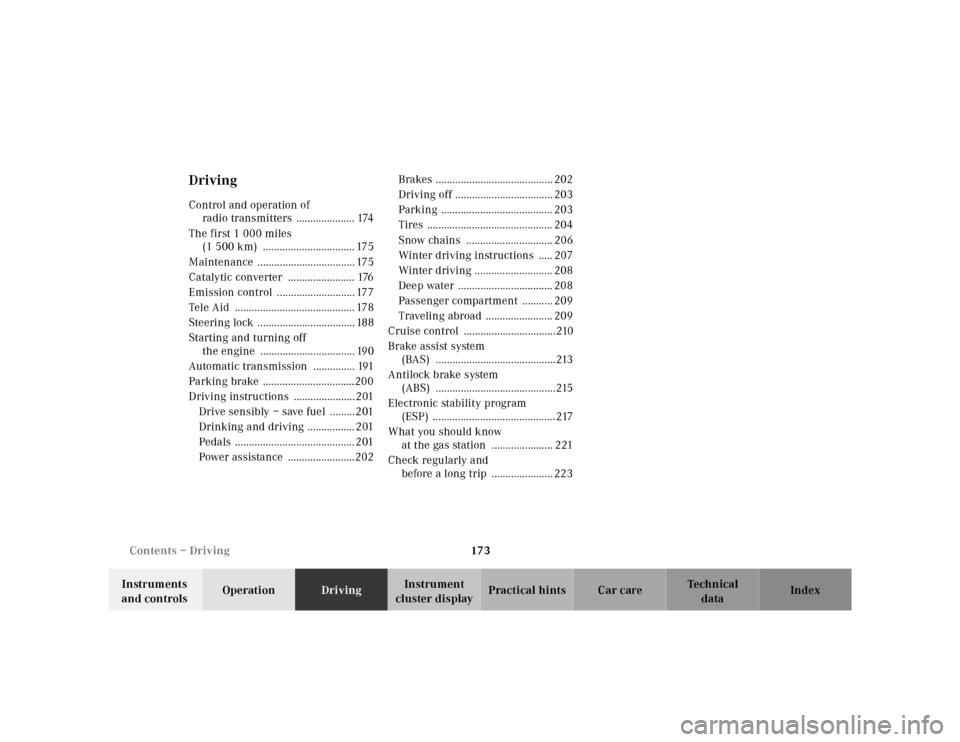
173 Contents – Driving
Te ch n ica l
data Instruments
and controlsOperationDrivingInstrument
cluster displayPractical hints Car care Index
DrivingControl and operation of
radio transmitters ..................... 174
The first 1 000 miles
(1 500 km) ................................. 175
Maintenance ................................... 175
Catalytic converter ........................ 176
Emission control ............................ 177
Tele Aid ........................................... 178
Steering lock ................................... 188
Starting and turning off
the engine .................................. 190
Automatic transmission ............... 191
Parking brake .................................200
Driving instructions ......................201
Drive sensibly – save fuel .........201
Drinking and driving ................. 201
Pedals ........................................... 201
Power assistance ........................202Brakes .......................................... 202
Driving off ................................... 203
Parking ........................................ 203
Tires ............................................. 204
Snow chains ............................... 206
Winter driving instructions ..... 207
Winter driving ............................ 208
Deep water .................................. 208
Passenger compartment ........... 209
Traveling abroad ........................ 209
Cruise control .................................210
Brake assist system
(BAS) ...........................................213
Antilock brake system
(ABS) ...........................................215
Electronic stability program
(ESP) ............................................217
What you should know
at the gas station ...................... 221
Check regularly and
before a long trip ...................... 223
Page 187 of 325
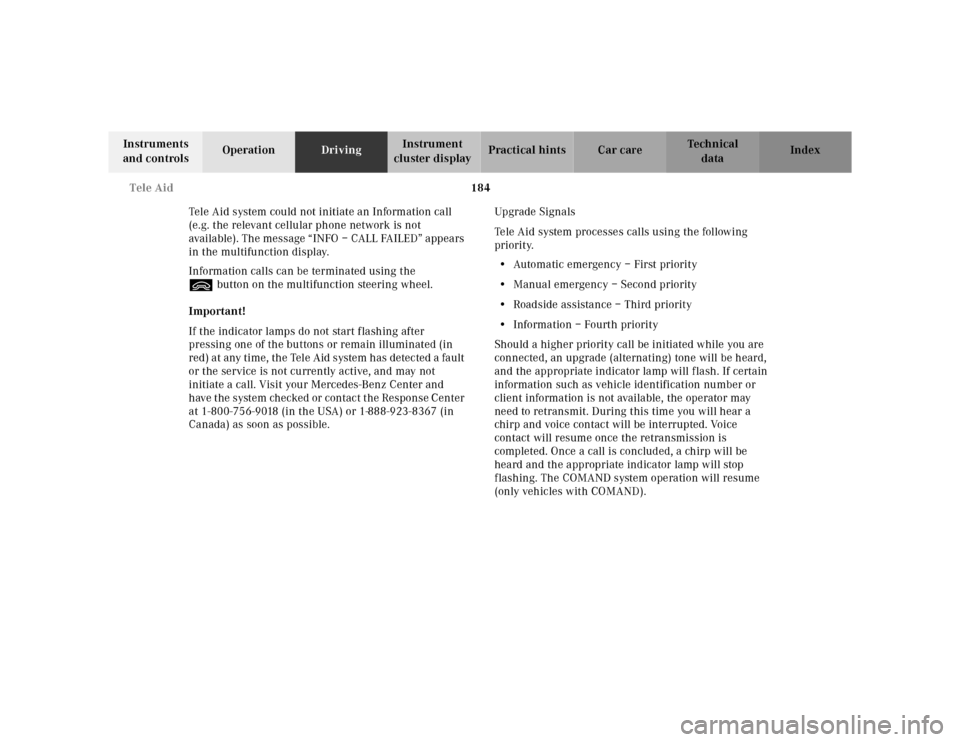
184 Tele Aid
Te ch n ica l
data Instruments
and controlsOperationDrivingInstrument
cluster displayPractical hints Car care Index
Tele Aid system could not initiate an Information call
(e.g. the relevant cellular phone network is not
available). The message “INFO – CALL FAILED” appears
in the multifunction display.
Information calls can be terminated using the
ìbutton on the multifunction steering wheel.
Important!
If the indicator lamps do not start flashing after
pressing one of the buttons or remain illuminated (in
red) at any time, the Tele Aid system has detected a fault
or the service is not currently active, and may not
initiate a call. Visit your Mercedes-Benz Center and
have the system checked or contact the Response Center
at 1-800-756-9018 (in the USA) or 1-888-923-8367 (in
Canada) as soon as possible.Upgrade Signals
Tele Aid system processes calls using the following
priority.
•Automatic emergency – First priority
•Manual emergency – Second priority
•Roadside assistance – Third priority
•Information – Fourth priority
Should a higher priority call be initiated while you are
connected, an upgrade (alternating) tone will be heard,
and the appropriate indicator lamp will flash. If certain
information such as vehicle identification number or
client information is not available, the operator may
need to retransmit. During this time you will hear a
chirp and voice contact will be interrupted. Voice
contact will resume once the retransmission is
completed. Once a call is concluded, a chirp will be
heard and the appropriate indicator lamp will stop
flashing. The COMAND system operation will resume
(only vehicles with COMAND).
Page 194 of 325
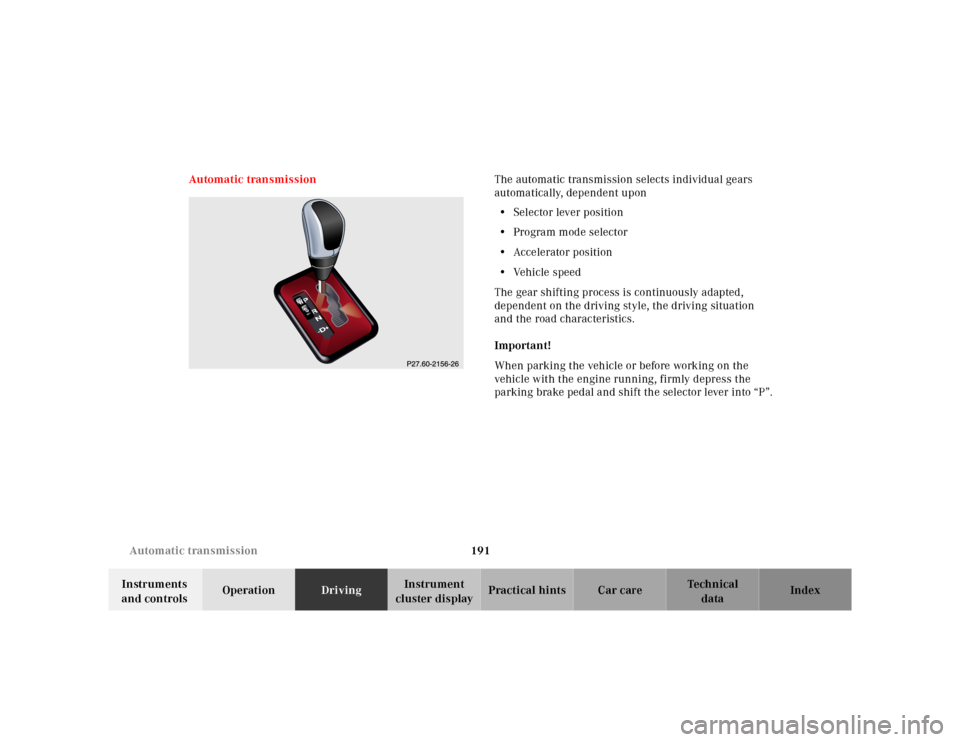
191 Automatic transmission
Te ch n ica l
data Instruments
and controlsOperationDrivingInstrument
cluster displayPractical hints Car care Index Automatic transmissionThe automatic transmission selects individual gears
automatically, dependent upon
•Selector lever position
•Program mode selector
•Accelerator position
•Vehicle speed
The gear shifting process is continuously adapted,
dependent on the driving style, the driving situation
and the road characteristics.
Important!
When parking the vehicle or before working on the
vehicle with the engine running, firmly depress the
parking brake pedal and shift the selector lever into “P”.
Page 195 of 325
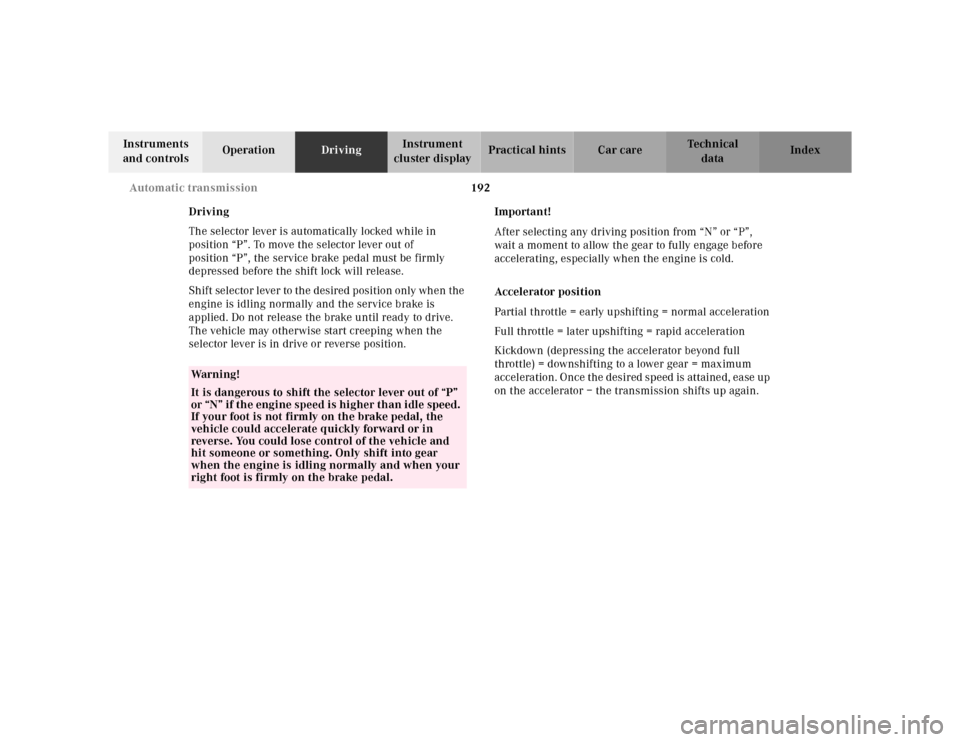
192 Automatic transmission
Te ch n ica l
data Instruments
and controlsOperationDrivingInstrument
cluster displayPractical hints Car care Index
Driving
The selector lever is automatically locked while in
position “P”. To move the selector lever out of
position “P”, the service brake pedal must be firmly
depressed before the shift lock will release.
Shift selector lever to the desired position only when the
engine is idling normally and the service brake is
applied. Do not release the brake until ready to drive.
The vehicle may otherwise start creeping when the
selector lever is in drive or reverse position.Important!
After selecting any driving position from “N” or “P”,
wait a moment to allow the gear to fully engage before
accelerating, especially when the engine is cold.
Accelerator position
Partial throttle = early upshifting = normal acceleration
Full throttle = later upshifting = rapid acceleration
Kickdown (depressing the accelerator beyond full
throttle) = downshifting to a lower gear = maximum
acceleration. Once the desired speed is attained, ease up
on the accelerator – the transmission shifts up again.
Wa r n i n g !
It is dangerous to shift the selector lever out of “P”
or “N” if the engine speed is higher than idle speed.
If your foot is not firmly on the brake pedal, the
vehicle could accelerate quickly forward or in
reverse. You could lose control of the vehicle and
hit someone or something. Only shift into gear
when the engine is idling normally and when your
right foot is firmly on the brake pedal.
Page 196 of 325
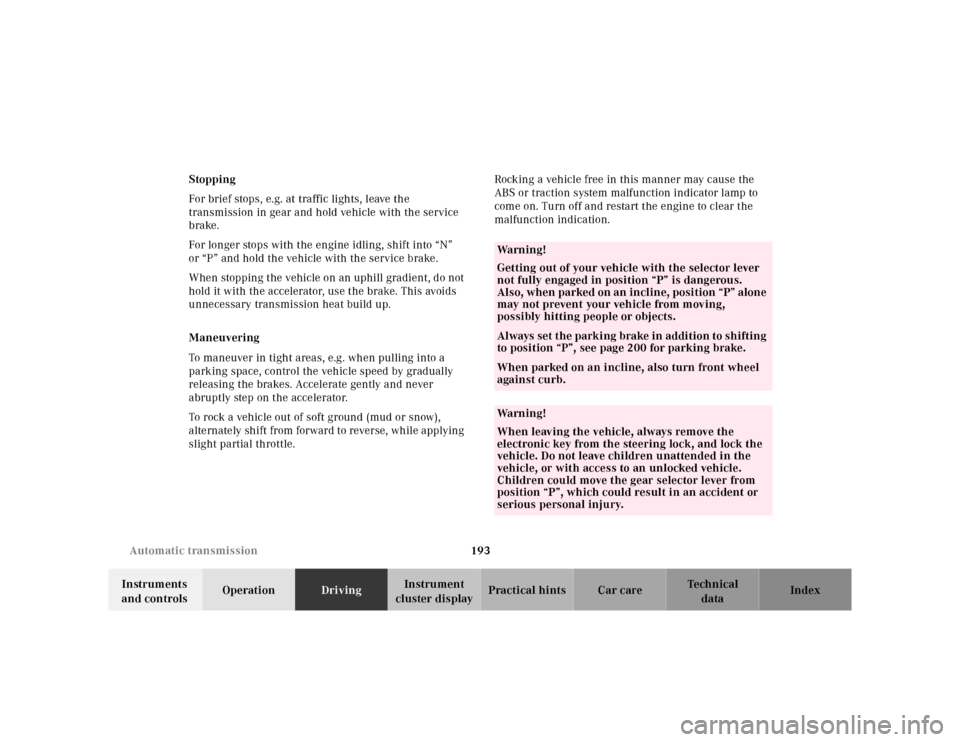
193 Automatic transmission
Te ch n ica l
data Instruments
and controlsOperationDrivingInstrument
cluster displayPractical hints Car care Index Stopping
For brief stops, e.g. at traffic lights, leave the
transmission in gear and hold vehicle with the service
brake.
For longer stops with the engine idling, shift into “N”
or “P” and hold the vehicle with the service brake.
When stopping the vehicle on an uphill gradient, do not
hold it with the accelerator, use the brake. This avoids
unnecessary transmission heat build up.
Maneuvering
To maneuver in tight areas, e.g. when pulling into a
parking space, control the vehicle speed by gradually
releasing the brakes. Accelerate gently and never
abruptly step on the accelerator.
To rock a vehicle out of soft ground (mud or snow),
alternately shift from forward to reverse, while applying
slight partial throttle.Rocking a vehicle free in this manner may cause the
ABS or traction system malfunction indicator lamp to
come on. Turn off and restart the engine to clear the
malfunction indication.
Wa r n i n g !
Getting out of your vehicle with the selector lever
not fully engaged in position “P” is dangerous.
Also, when parked on an incline, position “P” alone
may not prevent your vehicle from moving,
possibly hitting people or objects.Always set the parking brake in addition to shifting
to position “P”, see page 200 for parking brake. When parked on an incline, also turn front wheel
against curb.Wa r n i n g !
When leaving the vehicle, always remove the
electronic key from the steering lock, and lock the
vehicle. Do not leave children unattended in the
vehicle, or with access to an unlocked vehicle.
Children could move the gear selector lever from
position “P”, which could result in an accident or
serious personal injury.